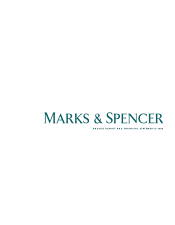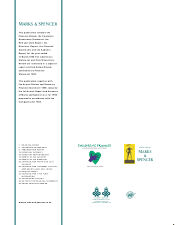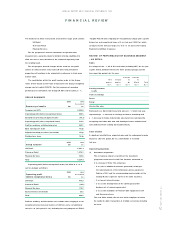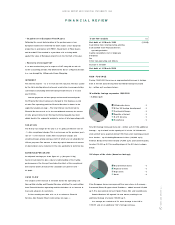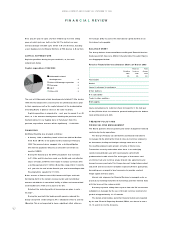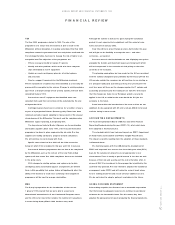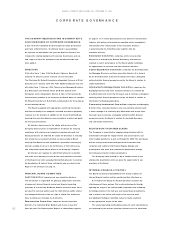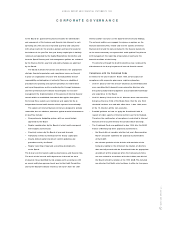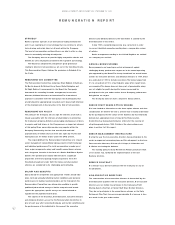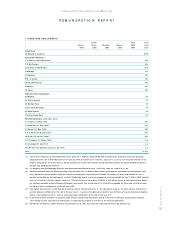Marks and Spencer 1999 Annual Report Download - page 7
Download and view the complete annual report
Please find page 7 of the 1999 Marks and Spencer annual report below. You can navigate through the pages in the report by either clicking on the pages listed below, or by using the keyword search tool below to find specific information within the annual report.
ANNUAL REPORT AND FIN ANCIAL STATEMENTS 1999
FIN AN CIAL REVIEW
Y2K
The Year 2000 programme started in 1996. The aim of the
programme is to ensure that the business is able to trade in the
Millennium without disruption. It is widely understood that Year 2000
compliance cannot be guaranteed and our analysis has confirmed this.
O ur strategy, therefore, has been to manage the risk of failure to an
acceptable level.The objectives of the programme are:
• W here necessary modify or replace IT systems
• Identify and solve problems which could arise from computer
chips embedded in non-IT equipment
• Update or create contingency plans for all critical systems
and processes
• Create a support framework for the Millennium weekend.
W here replacement of systems has been identified as a necessity, the
process will be complete by the autumn. Changes to existing systems,
apart from a small percentage of low priority systems, will have been
completed by June 1999.
O ur work on non-IT equipment has identified some non-
compliant items and their correction will be completed by the end
of September 1999.
Contingency plans have been in existence for a number of years,
as part of a progressive D isaster Recovery policy.These have been
reviewed and some require updating to take account of the unusual
circumstances of the Millennium.This work, and the complementary
Millennium support planning, is progressing well.
The key external risks to Marks & Spencer are its merchandise
and logistics suppliers. Since early 1998, a two-way communication
programme has been in place, augmented by site visits. O ur key
suppliers are making satisfactory progress towards compliance.
W e will continue to work closely with them.
Specific costs related to Year 2000 will be £26m across the
Group of which £9m is included in this year and £3m in last year.
O ur normal business programmes that are due to be completed
by the Millennium, such as the roll out of the new Point-of-Sale
systems, will also ensure Year 2000 compliance but are not included
in the above costs.
W ith changes to existing systems, new systems, up-to-date
contingency plans and detailed support arrangements, we believe
there is little possibility that system failure will significantly affect the
ability of the business to trade. O ur continuing risk management
programme will be used to manage eventualities.
EMU
The Group’s preparation for the introduction of the euro on
1 January 1999 ensured that we were able to accept euro
denominated transactions in all our Continental European stores
and the UK. As for most other retailers the number of transactions
in euros during January-March 1999 has been very small.
Although the number is forecast to grow during the transitional
period, it is not expected to be significant until the arrival of euro
notes and coins in January 2002.
N ew tills will be in all our European stores by O ctober this year,
and will give us the flexibility to accept the euro – and other
currencies – as required.
O ur two stores in the N etherlands are now displaying euro prices
alongside the Guilder, and important lessons are being learnt which
will be incorporated in the extension of dual pricing to the other
countries in the eurozone.
The planning assumptions we have made for the UK are consistent
with the national changeover plan published by the Treasury.W hile the
UK remains outside the eurozone, we will continue to use sterling as
our principal trading and accounting currency. O ur priority over the
next two years will focus on the changes required to IT systems and
accounting procedures, and the training of our staff. W e will ensure
that the changes we make to our European systems can also be
applied in the UK, to minimise the costs should the UK join the
eurozone in the future.
Costs incurred for the introduction of the euro to date are not
significant. Costs associated with UK entry remain difficult to forecast
until the timing is more certain.
ACCOUNTING DEVELOPMENTS
The Accounting Standards Board (ASB) has issued five Financial
Reporting Standards during the year (FRS11-15), all of which have
been adopted in this financial year.
The standards which have had most impact are FRS11,‘Impairment
of Fixed Assets and Goodwill’ and FRS15,‘Tangible Fixed Assets’.
The impact on profits resulting from the adoption of these standards
is discussed above.
W e held discussions with the ASBduring the development of
FRS15 and expressed our concern that the existing use value (EUV)
basis for the valuation of properties is not appropriate to our
circumstances.There is usually a ‘special interest’ in the sites we seek
because of their size and scarcity, and the cost is therefore often in
excess of EUV. O ur investment in these properties is justified by the
cash flow they generate.W e have therefore adopted the transitional
arrangement under FRS15 and will retain the current book values
for our existing properties and record all future additions at cost.
W e do not intend to adopt a policy of revaluation in the future.
GOING CON CERN STATEMENT
After making enquiries, the directors have a reasonable expectation
that the Group has adequate resources to continue in operational
existence for the foreseeable future. For this reason, they have
adopted the going concern basis in preparing the financial statements.
5
MARKS AN D SPEN CER p.l.c.

